Douglas DC-7C Spantax
Production Time 9 to 10 weeks
Shipment is by FedEx, UPS or DHL International Express Courier with a normal door-to-door delivery time worldwide of within 2-3 business days after dispatch. Due to the current volatility of world fuel prices, the amount mentioned here is our best estimate for DHL and UPS and may be subject to change at the time of shipping.

Model Description: Douglas DC-7C Spantax Wood Replica Scale Custom Model Aircraft
Manufacturer: Douglas
Wingspan: 17 Inches (43.2 Centimeters)
Height: 4.3 Inches (10.9 Centimeters)
Scale: 1:90
Registration: EC-ATR
$239.50
Production Time 9 to 10 weeks
-
United States dollar ($)
-
Pound sterling (£)
-
Euro (€)
-
Australian dollar ($)
-
Canadian dollar ($)
-
Singapore dollar ($)
-
Swiss franc (CHF)
-
Japanese yen (¥)
-
Danish krone (kr.)
-
Hong Kong dollar ($)
-
Norwegian krone (kr)
-
Swedish krona (kr)
-
United Arab Emirates dirham (د.إ)
General Product Description
Our PlaneArts Douglas DC-7C Spantax model exhibits unique, unrivaled quality and detailed design to come as close as possible to the accuracy of the actual plane. It comes as standard with a robust, durable base or stand which is available in a variety of different finishes designed to match your own personal requirements including solid wood, wood with polished metal supports or adjustable wood wall mount and will be ready within about 9-10 weeks from placement of order.
The Douglas DC-7C Spantax model is made of the finest kiln dried renewable mahogany wood (commonly known as Lauan or Meranti) which has undergone many stages of carving and meticulous and careful sanding giving the beautiful finished museum quality masterpiece. Many collectors and model connoisseurs demonstrate their preference for genuine handmade and hand painted mahogany wood models rather than plastic or die cast (diecast) alternatives due to the overall look and totally different feel of the item - we trust you will find the same. We can, however, if required produce the same model in Solid Cast Resin so just click and contact us us for further information. Our craftsmen and gifted artisans ensure that our finely handcrafted model airplanes match the precise blueprint details of the original aircraft. The paint scheme, markings and parts are closely matched, reflecting the original aircraft. This stylish top-quality desktop replica model will surely enthrall anyone who receives this as a gift and for sure one of the most appropriate and desirably collectable gifts for any aviation enthusiast and avid aircraft collector whilst also displaying a perfect resemblance to the actual aircraft.
If you require we can also make the Douglas DC-7C Spantax model in any other airline, private livery or colour scheme you require and if necessary in a different size or scale. Just click here to contact us with a description or photographs of what you require, and we will let you have a quotation for the necessary customization by return email. We can also make bespoke scale replicas of any other private / civil commercial airliner or airliners, helicopter, glider, gliders with engines, military jet, warplane jets, propeller warplanes, biplane, triplane, tail fin, spacecraft, rocket or NASA model you require in any airline, military or civilian livery or colors. We also produce model airships, blimp, dirigible, blimps, boat and ship collectibles. Wall plaque or seal for military, government or private customers. Again, by clicking here to contact us just let us know exactly what you need.
As you may or may not be aware the trade name and copyright permissions for Douglas aircraft are now under the ownership of the Boeing Company and as such, we are proud to be one of the very few international and fully licensed manufacturers of Boeing solid mahogany wood models. You may be interested to read more about the fascinating background to the famous aviation names now under the Boeing umbrella by clicking on the following “Officially Licensed Product” image below:
The Douglas DC-7C “Seven Seas” and its Legacy in Spantax’s Fleet
The Douglas DC-7C “Seven Seas” holds a special place in the annals of aviation history, marking a pinnacle in propeller-driven, long-haul aircraft before the jet age firmly took hold. This aircraft, introduced by Douglas Aircraft Company, was the ultimate iteration of the DC-7 series, designed to meet the demands of non-stop transatlantic flights. Among its users, Spantax, a Spanish airline, leveraged the DC-7C’s capabilities to enhance its operational range and service quality. This article delves into the important features and technical specifications that made the DC-7C a notable aircraft in commercial aviation, with a spotlight on its role within Spantax’s fleet.
Important Features of the DC-7C:
- Extended Range: The DC-7C was dubbed “Seven Seas” due to its enhanced range capabilities, enabling it to fly non-stop across the Atlantic and other long-haul routes. This was a significant achievement at the time, reducing travel times and connecting continents more efficiently.
- Advanced Propulsion: Powered by four Wright R-3350 Turbo-Compound engines, the DC-7C had a formidable power output. These engines were equipped with power recovery turbines, which recycled exhaust gases to boost power and efficiency.
- Increased Comfort: The cabin of the DC-7C was designed for passenger comfort, featuring improved soundproofing and air conditioning systems. This made long-haul travel more pleasant and accessible to a wider audience.
- Superior Performance: With its ability to operate at higher altitudes and its impressive cruising speed, the DC-7C offered airlines a blend of efficiency and performance that was unrivaled by other piston-engine aircraft of the era.
Technical Specifications:
- Wingspan: 127 feet 6 inches (38.86 meters)
- Length: 112 feet 3 inches (34.21 meters)
- Height: 31 feet 10 inches (9.70 meters)
- Maximum Takeoff Weight: 143,000 pounds (64,864 kilograms)
- Cruising Speed: Approximately 355 mph (570 km/h)
- Range: Up to 5,635 miles (9,070 kilometers) with maximum fuel
- Engines: Four Wright R-3350-18EA Turbo-Compound 18-cylinder radial engines, each producing 3,400 hp (2,535 kW)
- Seating Capacity: Typically 105 passengers in a two-class configuration
- Service Ceiling: 25,000 feet (7,620 meters)
Spantax utilized the DC-7C to expand its international operations, capitalizing on the aircraft’s long-range capabilities to offer flights to more distant destinations. The DC-7C enabled Spantax to compete on international routes, offering passengers comfort and speed that were unprecedented at the time for a propeller-driven aircraft.
Despite the advent of jet airliners, the DC-7C remained a vital part of Spantax’s fleet until the transition to faster and more efficient jet aircraft was inevitable. The legacy of the DC-7C in Spantax’s history is a testament to a time when propeller-driven aircraft bridged the gap between short-haul flights and the global connectivity we take for granted today.
In conclusion, the Douglas DC-7C “Seven Seas” was more than just an aircraft; it was a symbol of progress, connecting the world like never before. Its role within Spantax’s operations highlighted the airline’s commitment to offering cutting-edge service and bridged the era between propeller-driven flights and the jet age, leaving an indelible mark on the history of commercial aviation.
| Weight | 6 kg |
|---|---|
| Dimensions | 15 × 17 × 4.3 in |


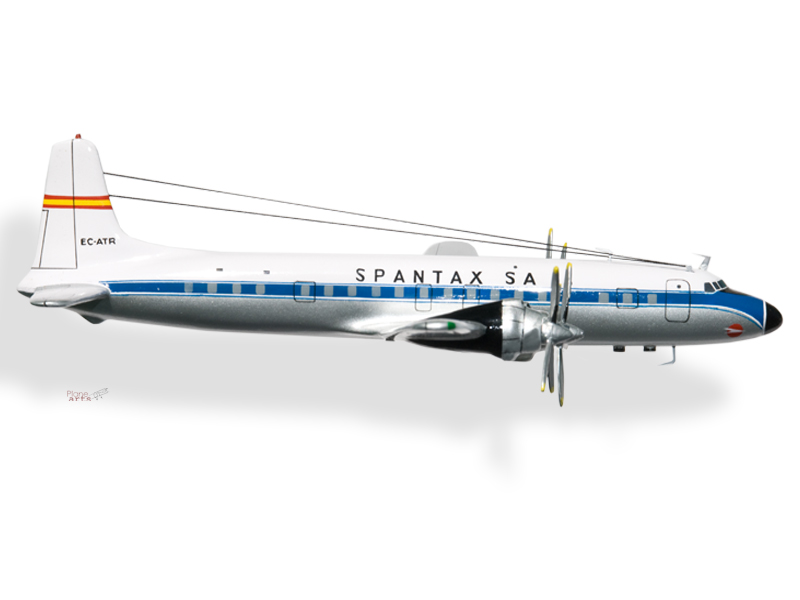

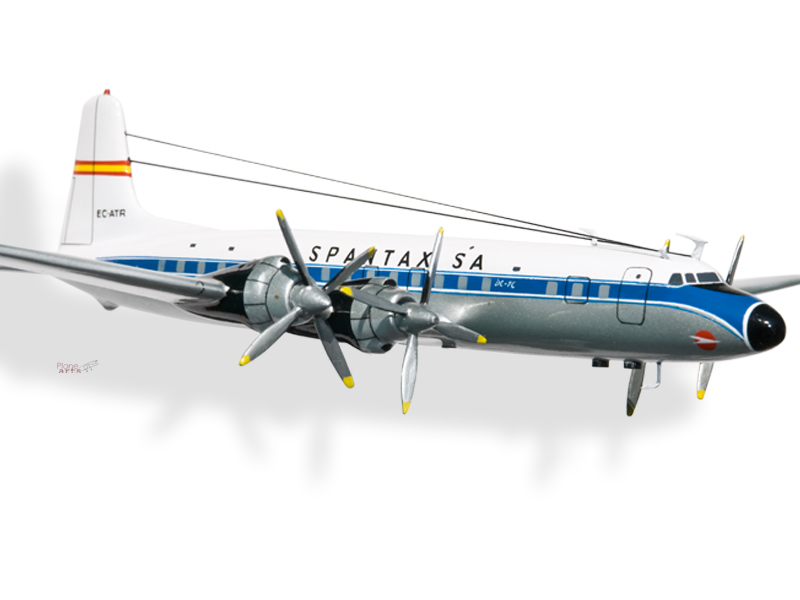
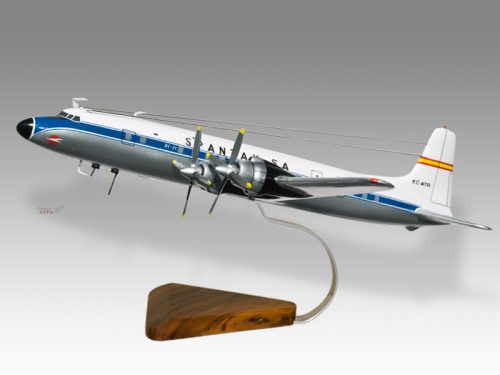

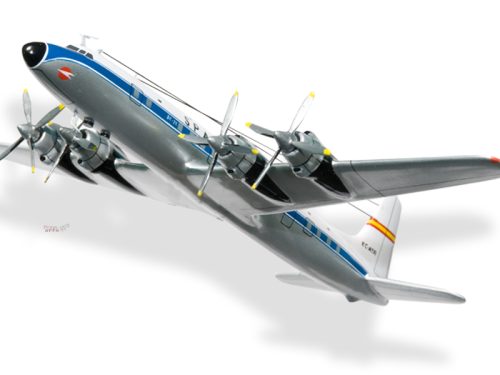

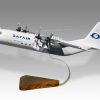
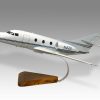

Reviews
There are no reviews yet.